10 Baking
Baking refers to the part of the process where you are loading your dough into the oven.1 Baking is typically done after your dough has gone through the bulk fermentation and proofing stage. This chapter will review what happens to your dough during baking, as well as several techniques used to improve the final result.
10.1 The process of baking🔗
Once temperature starts to rise, the dough will go through several stages as summarized in Table 10.1. As the dough heats up, the water and acids in your dough start to evaporate. When baking a gluten based dough, the bubbles in your dough start to expand. The dough starts to vertically rise, this is called oven spring. Your bread starts to build a crust of gel-like consistency, the crust is still extensible and can be stretched.
|
|
|
|||
| 60 / 140 | Sterilization |
The temperature is too hot for your microorganisms and they die. |
|||
| 75 / 167 | Gel building |
A gel builds on the surface persisting your dough’s structure. It is still extensible and can spring in the oven. |
|||
| 100 / 212 | Water evaporation |
Water begins to evaporate and inflates your dough’s alveoli. |
|||
| 118 / 244 | Acetic acid evaporation |
The vinegary tasting acid starts to evaporate, sourness decreases. |
|||
| 122 / 252 | Lactic acid evaporation |
The dairy tasting lactic acid begins to evaporate, sourness further decreases. |
|||
| 140 / 284 | Maillard reaction |
The Maillard reaction starts to deform starches and proteins. The dough starts browning. |
|||
| 170 / 338 | Caramelization |
Remaining sugars begin to caramelize giving your bread a distinct flavor. |
At around 60 °C (140 °F) the microbes in your dough start to die. There are rumors that until this happens the microbes produce a lot of CO, resulting in the dough’s expansion. However, this temperature is reached quickly. Furthermore, stress makes the microbes enter sporulation mode in order to focus on spreading genetics. More research should be done here to validate or invalidate this claim.
At 75 °C (167 °F) the surface of your dough turns into a gel. It holds together nicely but is still extensible. This gel is essential for oven spring as it retains the gas inside your dough.
At around 100 °C (212 °F) the water starts to evaporate out of your dough. If this weren’t the case, your dough would taste soggy and doughy. The higher hydration your dough has, the more water your bread still contains after the bake, changing its consistency. As a result the crumb is going to taste a bit more moist.
Another often undervalued step is the evaporation of acids. At 118 °C (244 °F) the acetic acid in your dough starts to evaporate. Shortly after at 122 °C (252 °F) the lactic acid begins evaporating. This is crucial to understand and it opens the door to many interesting ways to influence your final bread’s taste. As more and more water begins to evaporate the acids in your dough become more concentrated. There is less water but in relation you have more acids, therefore a shorter bake will lead to a more tangy dough. The longer you bake the bread, the more of the water evaporates, but also ultimately the acids will follow. The longer you bake, the less sour your bread is going to be. By controlling baking time you can influence which sourness level you would like to achieve.
It would be a very interesting experiment to bake a bread at different exact temperatures. How would a bread taste with only evaporated water but full acidity? What if you were to just completely get rid of the acetic acid? How would the taste change?
As the temperature increases further the crust thickens. The Maillard reaction kicks in, deforming proteins and starches. The outside of your dough starts to become browner and crisper, this process begins at around 140 °C (284 °F)
Once the temperature increases even more to around 170 °C (338 °F), the caramelization process begins, the remaining sugars and the microbes which did not convert yet start to brown and darken. You can keep baking for as long as you like to achieve the crust color that you like.2
The best method to know that your dough is done is to take the temperature of your dough, you can use a barbecue thermometer to measure it. Once the core temperature is at around 92 °C (197 °F), you can stop the baking process. This is typically not done though as the crust hasn’t been built yet.3
Once your dough has finished baking, it is ready to eat: your dough has turned into a bread. At this point, your bread is sterile as the temperature was too hot for for the microorganisms to survive.4
10.2 The role of steam🔗
Steam is essential when baking as it helps to counter premature crust building. During the first stage of the bake, the dough increases in size as the water in your dough evaporates and pushes the whole dough upwards.
Normally, under high heat a crust would form. Just like if you were to bake vegetables in your home oven, at some point they become darker and crisper. This is the same thing that happens with your dough, and you want to delay this process as long as possible until your dough no longer expands. Expansion stops when most of the microbes have died and the evaporating water no longer stays inside the alveoli.
The stronger the gluten network, the more gas can be retained during the baking process. This gluten network at some point loses its ability to contain gas as the temperature heats up. The dough stops increasing in size. The steam plays an important role as it condenses and evaporates on top of your dough. The surface temperature is rapidly increasing to around 75 °C (160 °F). At this temperature the gel starts to build, and is still extensible and allows expansion. Without the steam, the dough would never enter the gel stage, but instead directly go to the Maillard reaction zone. You want your dough to stay in this gel stage as long as possible to achieve maximum expansion.5
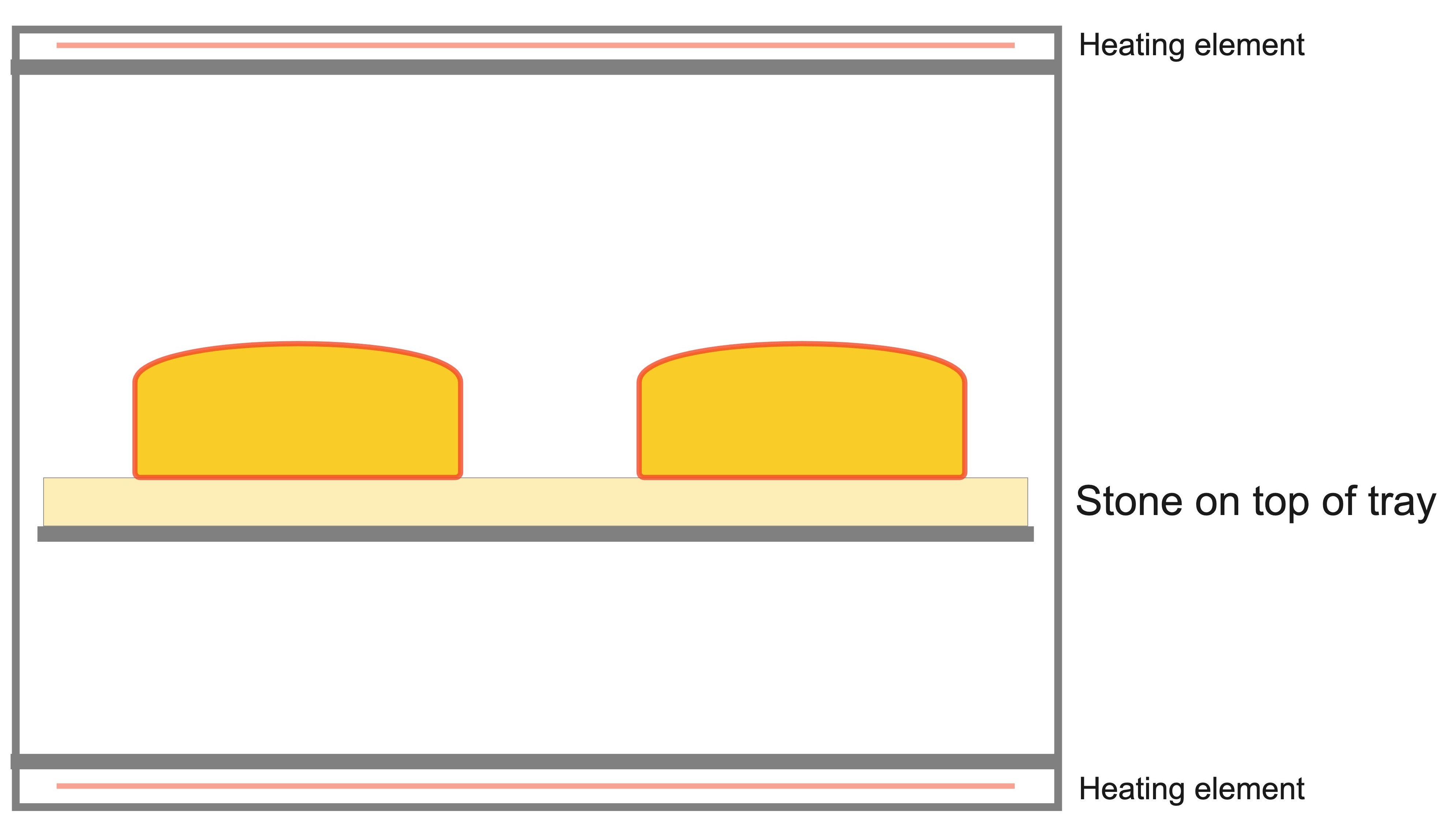
When not steaming enough, you will notice that the scoring incisions do not properly open up during the bake. They stay closed as the dough is unable to push through the crust. Another common sign, as you can see in Figure 10.3 is that you have larger pockets of air towards the crust of your dough. As the dough increases vertically, expansion is halted by the crust. The pockets of air converge into larger pockets as the pressure increases. This can also happen when you are baking at too high a temperature.
The more you steam, the softer your dough’s crust is. You will never enter the Maillard and caramelization stage. This is the reason why the source of steam is removed for the second stage of the bake. No more expansion can happen and you can focus on building a crust. If you would like a soft crust, you can steam your dough all the way.
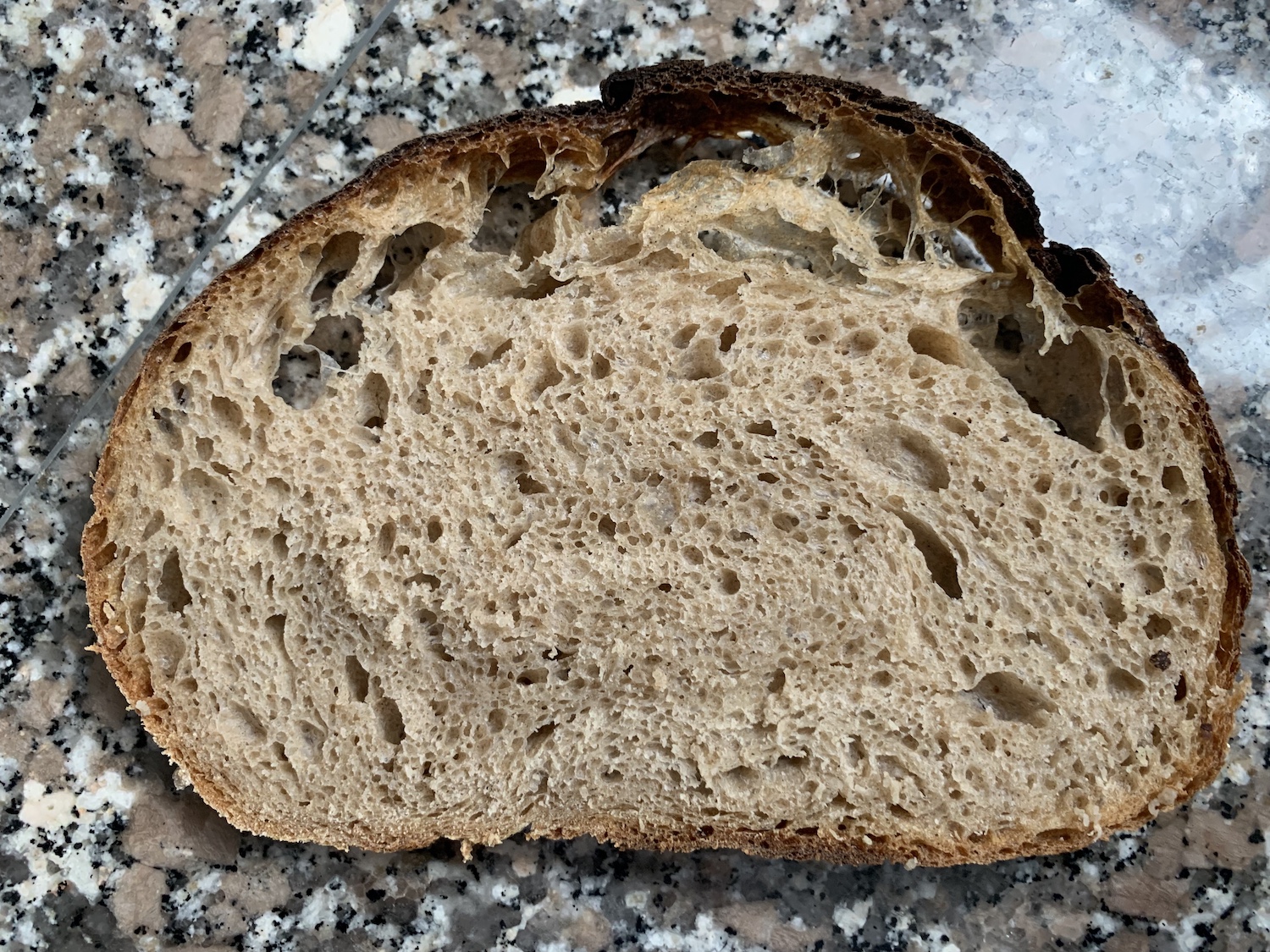
10.3 Building up steam🔗
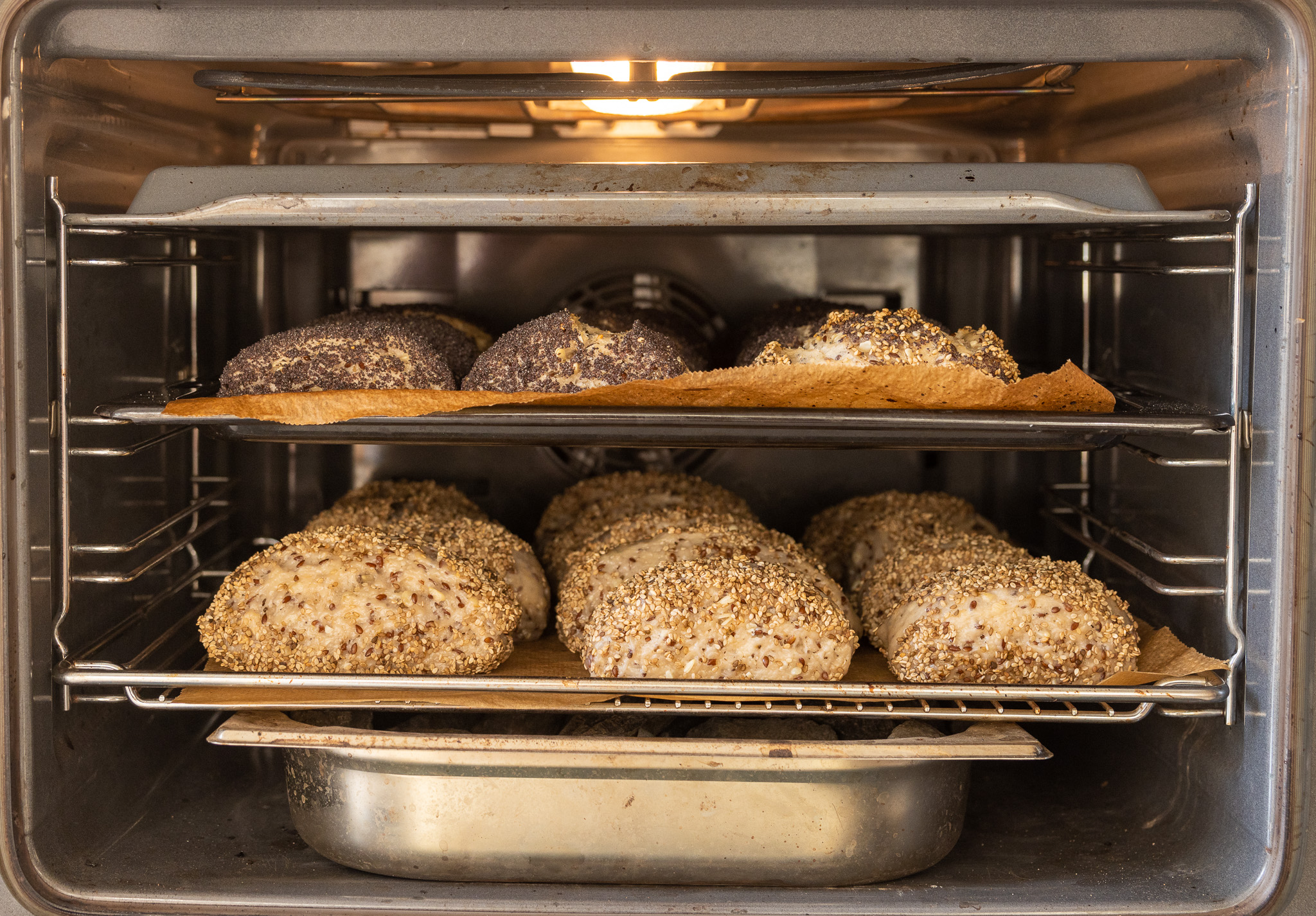
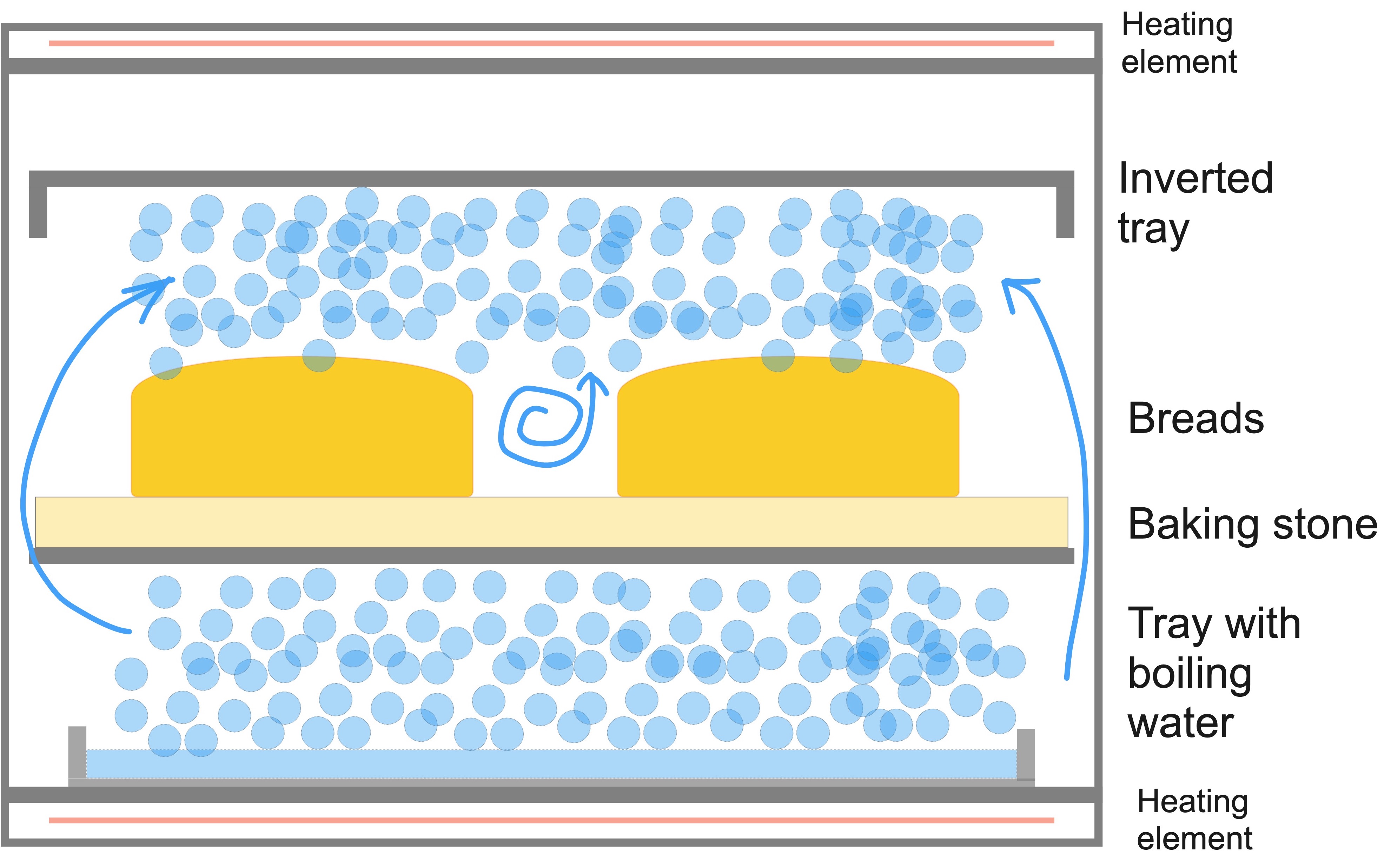
10.3.1 Dutch ovens🔗
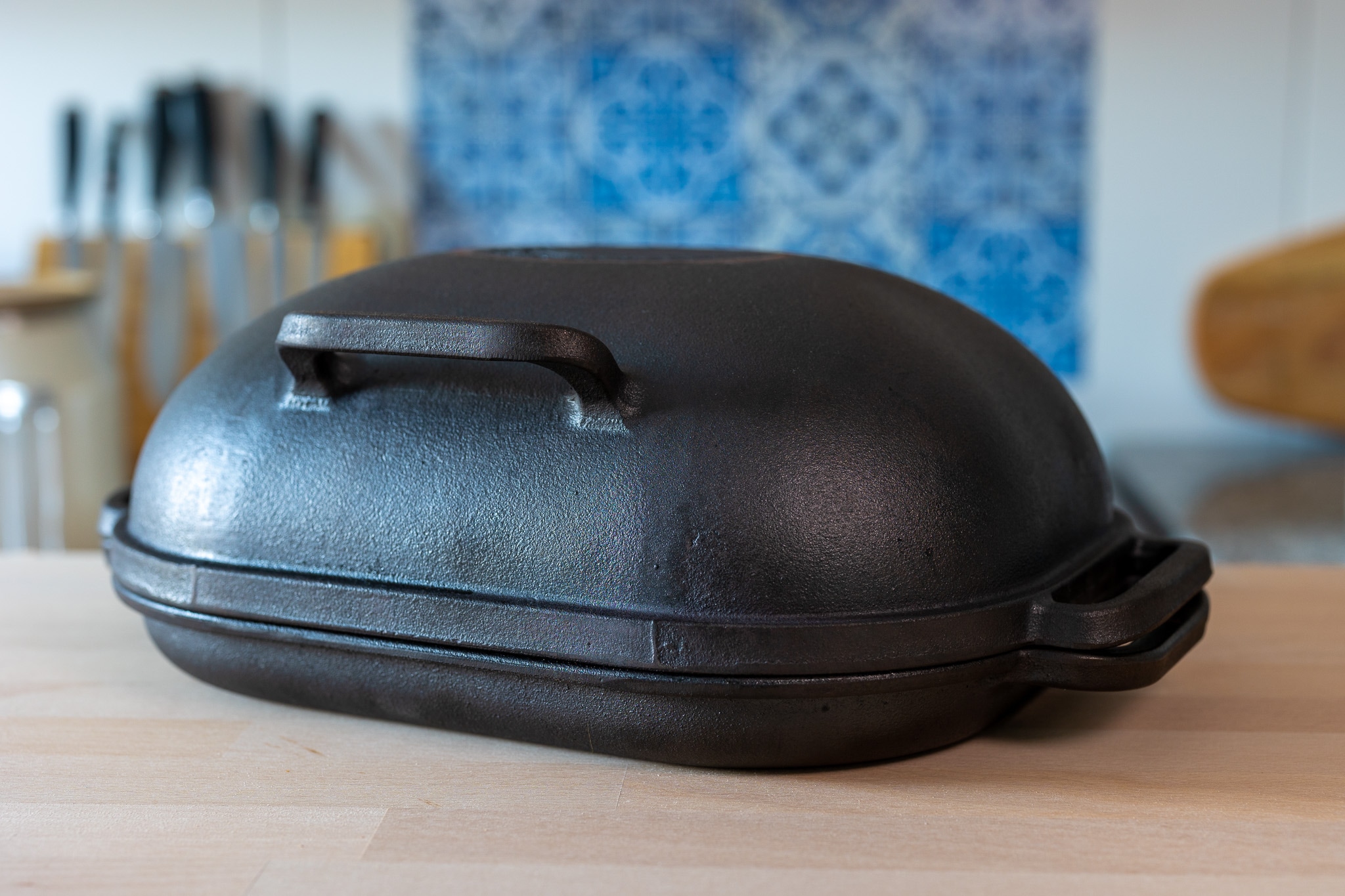
Dutch ovens are an ideal way to bake with a lot of steam. They are not fully sealed. Regardless though, as water evaporates from your dough, it will create a steamy environment allowing your dough to rise. It makes baking in a home oven very easy.
When using a Dutch oven, make sure to preheat it properly, this way your dough will not stick to it. You can also use additional semolina flour or parchment paper. Another good trick is to spritz your dough with a bit of water. To create more steam, you could also place a small ice cube next to your main dough.
I have been using a Dutch oven myself for a long time. They have issues though. They are relatively heavy. It is dangerous to operate hot cast iron ovens. Especially when working with steam, you have to be very careful. Furthermore, they are expensive to buy. If your Dutch oven is made out of cast iron you have to season it from time to time. This takes time.
The biggest disadvantage, though, is capacity. You can only bake a single piece of bread at a time, as the size of the Dutch oven is limited. In many cases, it makes sense to bake multiple loaves in one go. It makes the whole process more efficient as you have to knead less per loaf. The time it takes to make one loaf is significantly reduced on average. Furthermore, you don’t require as much energy. You don’t have to preheat your oven twice for each loaf.
An additional disadvantage of Dutch ovens is the need to move very hot and heavy cast iron.6 You will need to be very careful and ideally use heat-resilient gloves when touching your Dutch oven.
Furthermore, some of the Dutch ovens come at a hefty price tag. Especially for new bakers buying a Dutch oven on top of other tools can be quite a hefty investment. For this reason, I advocate the inverted tray method visualized in the next section. In case you do not own an oven consider trying the simple flatbread recipe which is baked in a pan. Please refer to Section 6.2.2 for more details.
10.3.2 Inverted tray method🔗
The inverted tray method simulates a Dutch oven. By placing another tray on top of your dough, the steam created from the dough and water source stays around your dough.
The biggest advantage of this method compared to the Dutch oven is scalability. You can bake multiple loaves at the same time. In my case that is around 2 freestanding loaves and 4 loaves in a loaf pan.
For the inverted tray you will need the following tools:
- 2 trays
- 1 heat resistant bowl
- Boiling water
- Oven gloves
- (Optional) Parchment paper
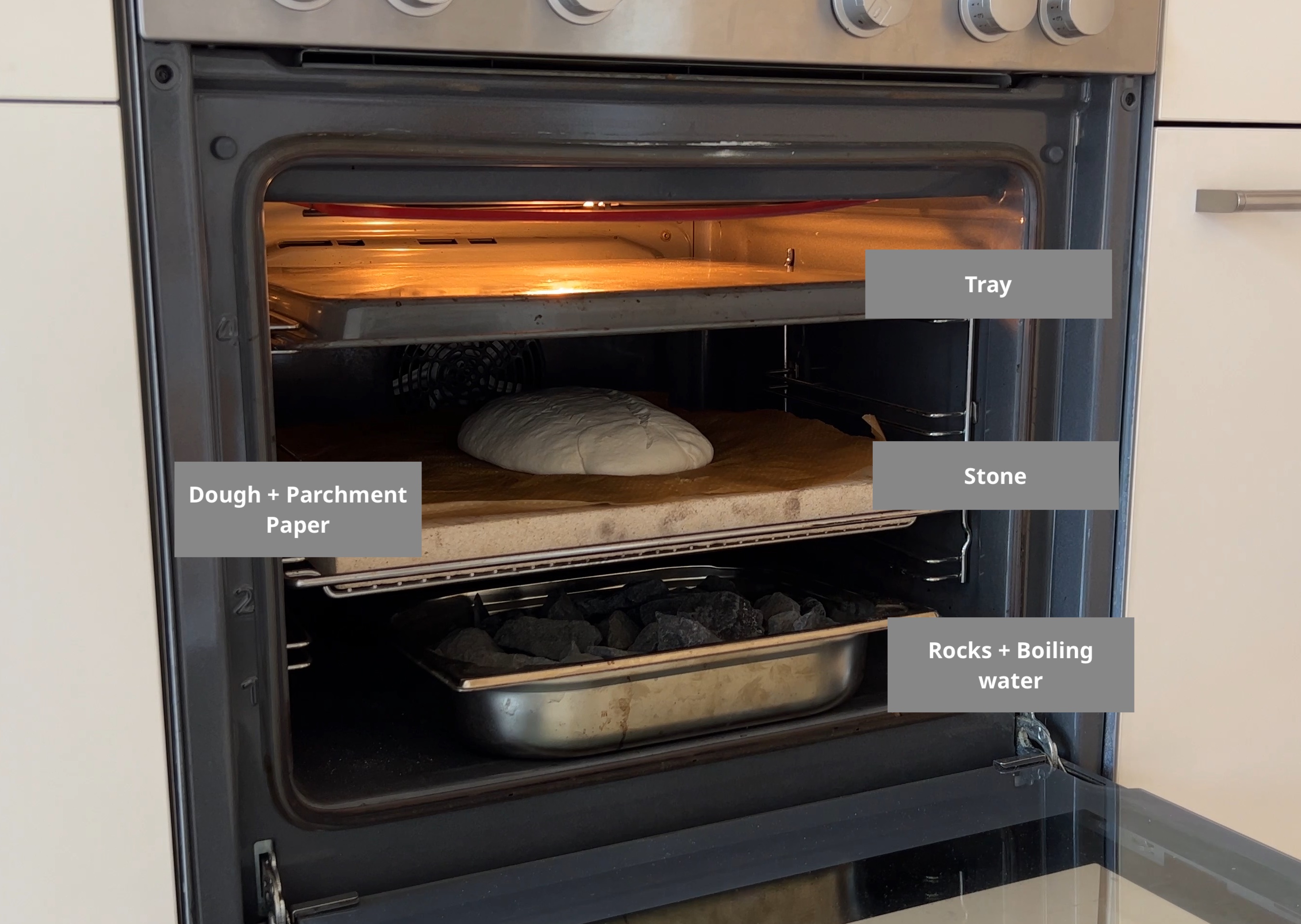
These are the steps to follow with the inverted tray method:
- Preheat the oven to around 230 °C (446 °F) and preheat one of the trays.
- Bring water to boil.
- Place your loaves on a piece of parchment paper. You can also place each on a tiny piece of parchment paper. This makes loading the dough easier. If you don’t have it or don’t want to use it, you can opt for semolina flour. It helps to make the tray nonstick.
- Take out your hot tray and place it on a cooling rack or on something else that is heat resistant.
- Score your doughs.
- Place your doughs on the hot tray.
- Place the cold tray in your oven in an inverted position.
- Move your hot tray including the loaves back to the oven.
- Place the boiling water in the heat-resistant water bowl. I have added rocks to it, as it helps to improve the steam even further. This is optional.
- Close the oven.
- After 30 minutes remove the top tray. Also remove the bowl with water.
- Finish baking your bread until you have reached your desired crust color. In my case this is another 15–25 minutes typically.
10.4 Conclusions🔗
|
|
|
|
||||
|
Gas |
No | No | Yes | ||||
|
Convection (Fan always on) |
No | No | Yes | ||||
|
Convection (Fan can be disabled) |
No | Yes | Yes | ||||
|
Steam |
Yes | Yes | Yes |
Depending on your home oven, a different method of steaming may be used. Generally most ovens are made to vent out most of the steam during the bake. They are typically not fully closed. During baking you want to dry out whatever you are baking. This is ideal if you are roasting vegetables and want them to dry out. For baking though, this is highly problematic. As described earlier, you want there to be as much steam as possible.
If you are using a gas-based oven, the only option is to utilize a Dutch oven. The same is true when you are using a convection oven with a fan that cannot be disabled. When using a convection oven with a fan that can be turned off, you can opt to use the cost-efficient inverted tray method.
If you are in the luxurious position of owning a steam oven, things are easier. Just activate the steam function and you are good to go. Placing an additional tray on top of your dough during the bake helps to bake with indirect heat. You remain in the gel zone longer and will experience more oven spring.
1While some breads like flatbreads could also be baked on the stove. This chapter focuses on the home oven.
2This really depends a lot on your personal preference. Some people prefer a darker crust, others prefer a more pale crust. It’s better to build less crust than too much. You can always just heat your bread in the oven one more time to continue building a darker crust.
3The thermometer is especially important when using a large loaf pan. It is sometimes very hard to judge from the outside if the dough is done. I failed many times and ended up having a semi baked dough.
4I wonder though if a starter culture could be grown again from a slice of bread. Under heat stress the microorganisms begin sporulating. Maybe some of the spores survive the baking process and could be reactivated later? If this works, you could use any store bought sourdough bread as a source for a new starter.
5You can remove your dough from the oven after 5 minutes to see the gel. You will notice that it holds the dough’s structure and it has a very interesting consistency.
6Some of them can weigh up to 10 kg. Moving them is quite a tedious exercise. Especially if the cast iron is heated you have to be very concise with your movements. Despite doing my best I have a few scars on my hands and arms from operating the Dutch ovens.
